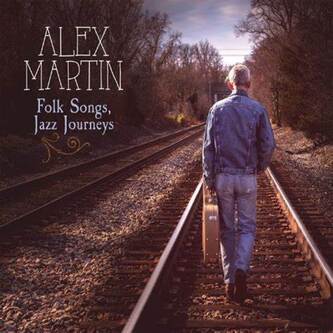
Alex Martin’s third album, Folk Songs, Jazz Journeys, is the almost inevitable result of a life of travel and musical exploration. Born in France, raised in rural North Carolina, and traveling through Latin America, Alex has absorbed the sounds of cultures varied and vivacious. The musical scope on this album travels from West Africa to Appalachia to Brazil to Europe. The folk songs are spun up with Jazz sensibilities Alex’s trio with their guest artists turn the effort into a brilliant work of Jazz diplomacy.
The trio is comprised of Alex on guitar with Ethan Foote and Tyler Sherman on bass, and Keith Butler, Jr. on drums. Joining them are vocalists Elin Melgarejo, Maya Rogers, and Lynn Véronneau along with Uasuf Gueye on balafon, Jodi Beder on cello, Deepak Shenoy on table, Bruno Lucini on triangle, and Gaby Kerdoncuff on trumpet.
Of the eleven tracks on the album, five were composed by Alex with him arranging or co-arranging all of the eleven songs. The first of his original songs, and the first on the album, is Postal de Bata which Alex calls, “a musical postcard to my wife, Leslie, after a short trip I took to Equatorial Guinea.” The instrumental features Uasuf Gueye on balafon, the West African musical instrument that resembles a xylophone. But at the halfway mark, Alex takes the lead with guitar that shows his excellent touch and timbre. A fine way to open an album.
Wayfaring Stranger is a traditional Appalachian tune introduces Maya Rogers on vocals with her sweet and warm intonations. The Jazz rendering is brilliant in both vocals and guitar. The Kudzu, the Dust, and You is what Alex calls his “Piedmont response to the Appalachian ballad Wayfaring Stranger.” If you’re not from the South (or Japan), Kudzu is the invasive plant from the Pacific that was introduced to the US in 1876. It has become known as “the plant that ate the South.” The trio performs the original instrumental and the sounds of hot air and sweltering souls is almost palpable.
Also an original, Viceversa is based on the poem by Mario Benedetti which reads:
I have a fear of seeing you
the need to see you
the hope of seeing you
an unease about seeing you.
I have a hunger to find you
the worry about finding you
the certainty of finding you
some slight doubts about finding you.
I have an urge to hear you
the happiness of hearing you
the good fortune of hearing you
and the fear of hearing you.
And this means
in short
that I’m screwed up
and radiant
perhaps more the former
than the latter
but also
vice versa.
The song sees the return of Maya Rogers and her beautiful dialect singing. Again, the delicate touch of Alex and the Butler/Sherman rhythm section is spot on.
Alex continues his dialogue between his compositions and the traditional songs in the pairing of Asa Branca by Luis Gonzaga and Humberto Teixeira and Triângulo. Alex says Triângulo “answers the Brazilian nordestino anthem Asa Branca.” Erin Melgarejo is the featured vocalist on both songs with Deepak Shenoy on tabla, and Bruno Lucini on triangle.
Rue Des Ursulines pairs off with Les Temps Des Cerises with the first an instrumental and the latter featuring Lynn Véronneau on vocals. Rue Des Ursulines is a street in New Orleans’ French Quarter (Vieux Carré). The song is a catchy, energetic approach to the music loved by Dr. John and others. Les Temps Des Cerises (The Time of Cherries) is based on the poem by Jean-Baptiste Clement with the melody from Antione Renard from 1866. It was and is extremely popular in French-speaking countries and was recorded by Yves Montand. Alex describes that the song was “associated with the Paris Commune of 1871 but still sung whenever the spirit of resistance must be revived. It was again in the air in Nazi-occupied Paris, which is where my grandparents met, fell in love, and first heard the song.”
How can you not love a song like that?
Then off to Celtic lands with I Once Loved a Lass, a traditional Scottish tune with Jody Beder on cello, and Laridé, a traditional Breton song with Bagy Kerdoncuff on trumpet. I Once Loved a Lass is a beautiful tune with sweet guitar and a wonderfully reflective cello. Laridé is a completing of the circle between the place of Alex’s birth (Brittany in France) and the place he now calls home (Washington, DC).
The album closes with Estamos Aqui Para Colaborar (Here to Work Together/La Pierre Deviant Temple) and it is only the trio of Alex Martin, Keith Butler, Jr., and Ethan Foote that bring it all to a satisfying conclusion.
Alex Martin’s Folk Songs, Jazz Journeys is the best of many worlds, brought together from the lineage and experiences of Alex, then interpreted in Jazz idioms that are, at the same time, exciting and warm. It is summed up by the lines quoted from Antione de Saint-Exupery: “On my own, I cannot hope to escape my solitude. The stone cannot hope to be other than stone. But assembled, stones build and become a temple.”
Alex Martin has created a temple of music stones.
~Travis Rogers, Jr. is The Jazz Owl
 RSS Feed
RSS Feed
